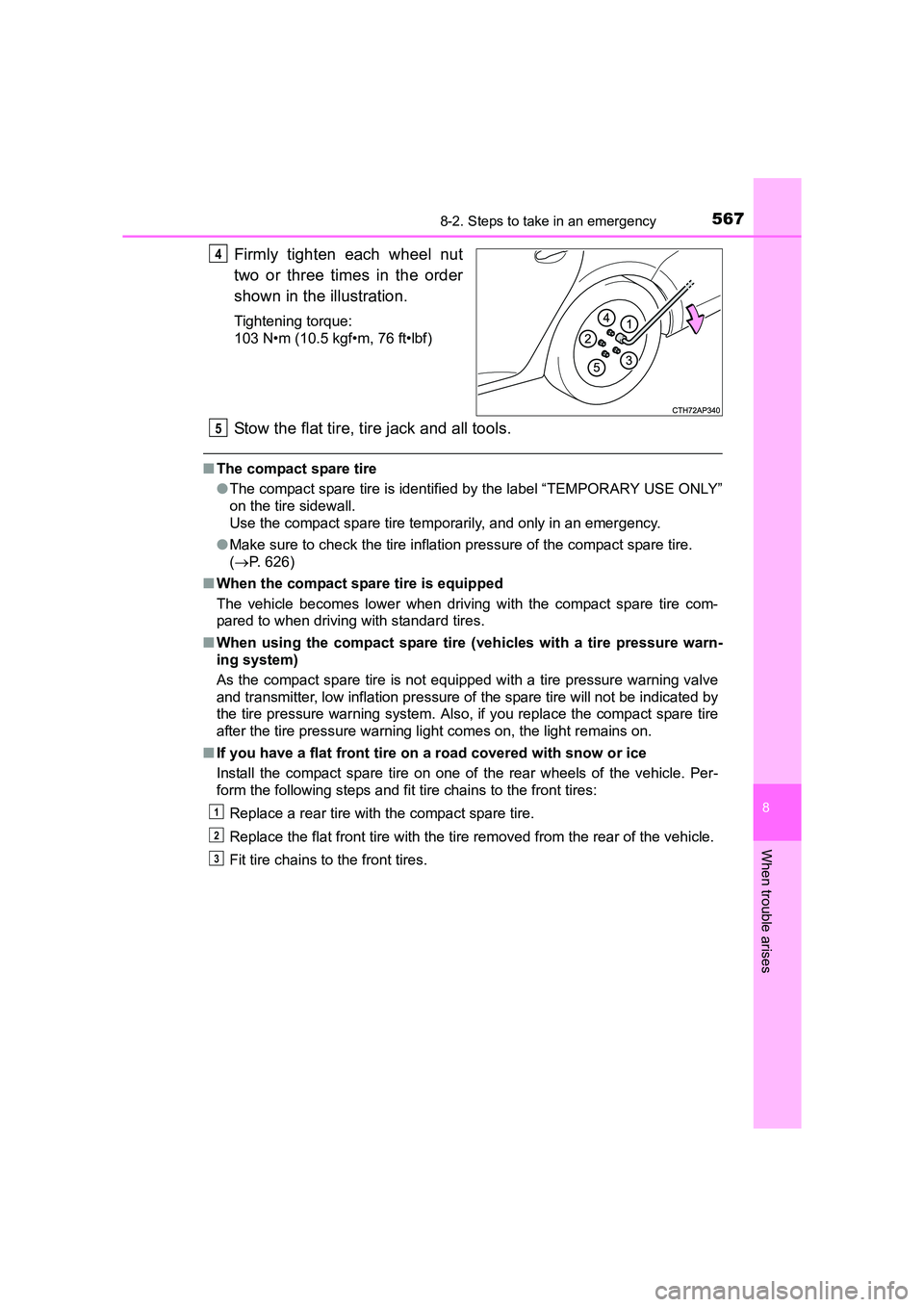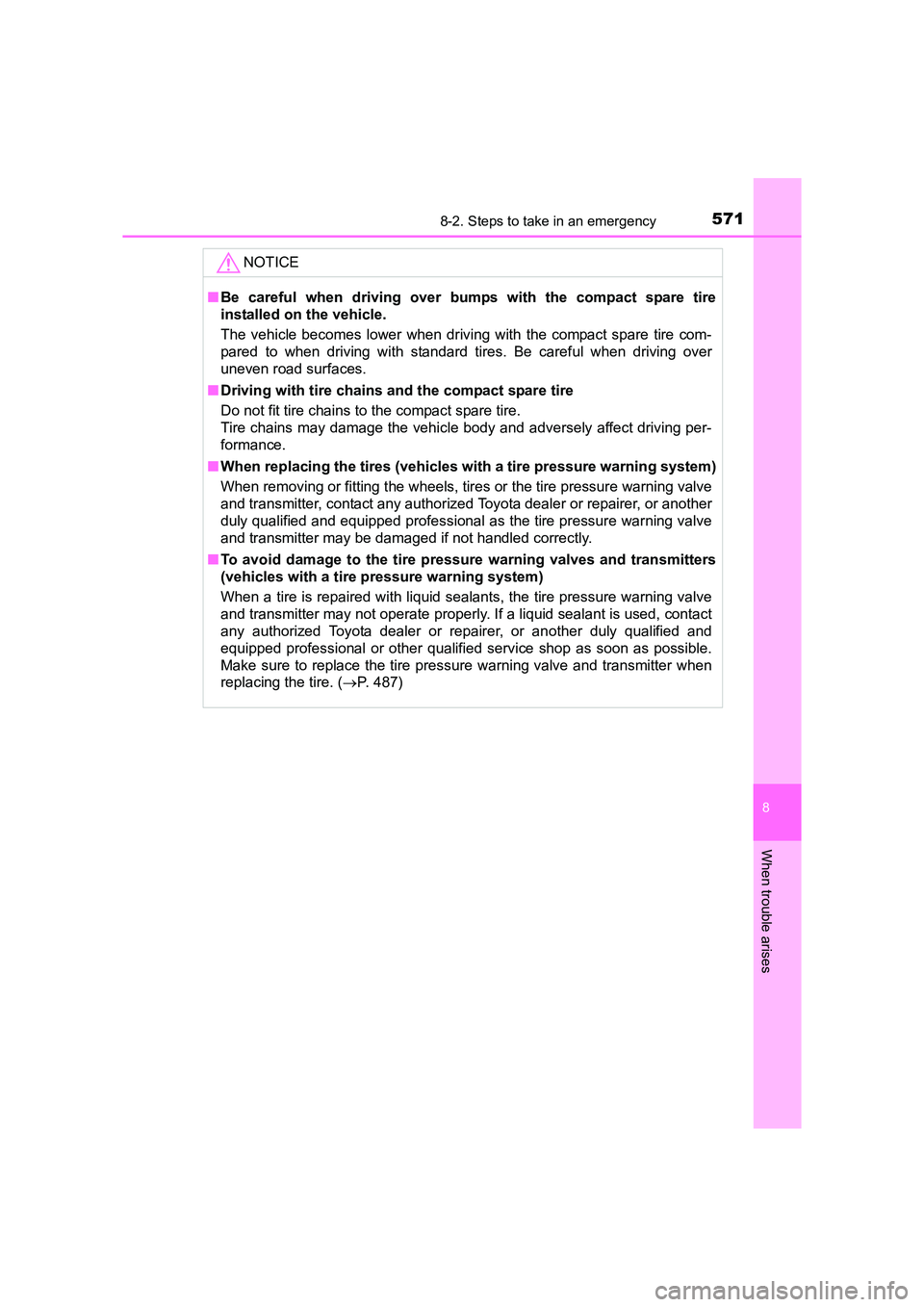Page 567 of 660

5678-2. Steps to take in an emergency
AURIS Touring Sports_EE (12K53E)
8
When trouble arises
Firmly tighten each wheel nut
two or three times in the order
shown in the illustration.
Tightening torque:
103 N•m (10.5 kgf•m, 76 ft•lbf)
Stow the flat tire, tire jack and all tools.
■The compact spare tire
●The compact spare tire is identified by the label “TEMPORARY USE ONLY”
on the tire sidewall.
Use the compact spare tire temporarily, and only in an emergency.
● Make sure to check the tire inflation pressure of the compact spare tire.
(→ P. 626)
■ When the compact spare tire is equipped
The vehicle becomes lower when driving with the compact spare tire com-
pared to when driving with standard tires.
■ When using the compact spare tire ( vehicles with a tire pressure warn-
ing system)
As the compact spare tire is not equipped with a tire pressure warning valve
and transmitter, low inflation pressure of the spare tire will not be indicated by
the tire pressure warning system. Also, if you replace the compact spare tire
after the tire pressure warning light comes on, the light remains on.
■ If you have a flat front tire on a road covered with snow or ice
Install the compact spare tire on one of the rear wheels of the vehicle. Per-
form the following steps and fit tire chains to the front tires:
Replace a rear tire with the compact spare tire.
Replace the flat front tire with the tire removed from the rear of the vehicle.
Fit tire chains to the front tires.
4
5
1
2
3
Page 571 of 660

5718-2. Steps to take in an emergency
AURIS Touring Sports_EE (12K53E)
8
When trouble arises
NOTICE
■Be careful when driving over bumps with the compact spare tire
installed on the vehicle.
The vehicle becomes lower when driving with the compact spare tire com-
pared to when driving with standard tires. Be careful when driving over
uneven road surfaces.
■ Driving with tire chains and the compact spare tire
Do not fit tire chains to the compact spare tire.
Tire chains may damage the vehicle body and adversely affect driving per-
formance.
■ When replacing the tires (vehicles wi th a tire pressure warning system)
When removing or fitting the wheels, tire s or the tire pressure warning valve
and transmitter, contact any authorized Toyota dealer or repairer, or another
duly qualified and equipped professional as the tire pressure warning valve
and transmitter may be damaged if not handled correctly.
■ To avoid damage to the tire pressure warning valves and transmitters
(vehicles with a tire pressure warning system)
When a tire is repaired with liquid sealants, the tire pressure warning valve
and transmitter may not operate properly. If a liquid sealant is used, contact
any authorized Toyota dealer or repairer, or another duly qualified and
equipped professional or other qualified service shop as soon as possible.
Make sure to replace the tire pres sure warning valve and transmitter when
replacing the tire. ( →P. 487)
Page 627 of 660
6279-1. Specifications
AURIS Touring Sports_EE (12K53E)
9
Vehicle specifications
�XCompact spare tire
■When towing a trailer
Add 20.0 kPa (0.2 kgf/cm2 or bar, 3 psi) to the recommended tire inflation
pressure and drive at speeds below 100 km/h (62 mph).
Tire sizeT125/70D17 98M
Tire inflation pressure
(Recommended cold
tire inflation pressure)
420 kPa (4.2 kgf/cm2 or bar, 60 psi)
Wheel size17 × 4 T
Wheel nut torque103 N•m (10.5 kgf•m, 76 ft•lbf)
Page 655 of 660

655Alphabetical index
AURIS Touring Sports_EE (12K53E)
SensorAutomatic headlight system ................................ 237
Automatic High Beam system ................................ 251
Inside rear view mirror .......... 177
LDA (Lane Departure Alert) ................................... 268
PCS (Pre-Crash Safety system) ............................... 251
Rain-sensing windshield wipers ................................. 243
RSA (Road Sign Assist) ........ 277
Toyota parking assist-sensor ...................... 305
Shift lever ......................... 223, 228 If the shift lever cannot be shifted from P ................ 590
Manual transmission ............. 228
Multidrive............................... 223
Shift lock system ..................... 590
Side airbags ............................... 42
Side mirrors.............................. 178 Adjusting and folding............. 178
Side turn signal lights ............. 231 Replacing light bulbs ............. 515
Turn signal lever ................... 231
Wattage................................. 628 Simple-IPA................................ 312
Smart entry & start system ..... 145
Antenna location ................... 145
Entry functions .............. 134, 140
Starting the engine................ 213
Snow tires ................................ 336
Spare tire .................................. 559 Inflation pressure .................. 627
Storage location.................... 560
Spark plug ................................ 622
Specifications .......................... 608
Speech command system
*
Speed limiter ............................ 301
Speedometer .............................. 98
Sport mode............................... 224
Steering lock ............................ 219 Column lock release ..... 211, 220
Steering wheel ......................... 174
Adjustment ............................ 174
Audio switches
*.................... 339
Stop & Start cancel switch ..... 285
Stop & Start system ................ 283
Stop lights Replacing light bulbs............. 515
Wattage ................................ 628
Storage feature ........................ 421
*: For vehicles with navigation/multimedia system, refer to “Navigation and multimedia system Owner’s manual”.